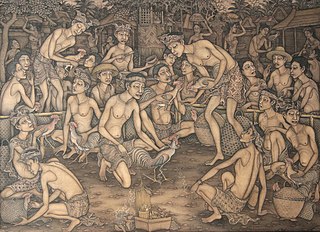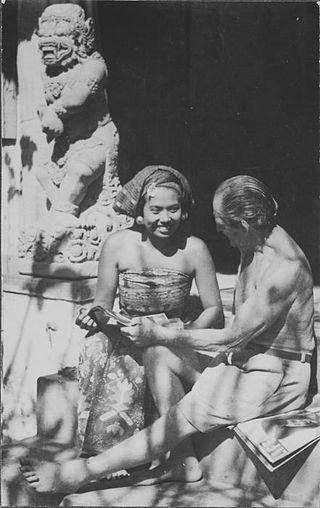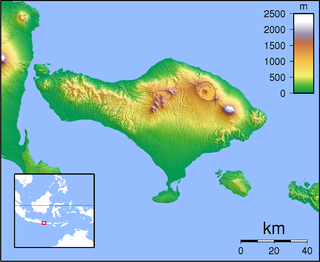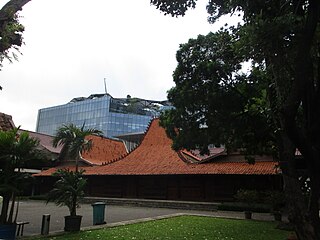Adrianus Wilhelmus "Arie" Smit was a Dutch-born Indonesian painter who lived on Bali.
A Balinese name is part of a system of identification used by the Balinese people and in the western parts of the neighboring island of Lombok, Indonesia. A Balinese name will have three parts: a title, a birth order name and a personal name. Balinese people do not use a family name.
I Ketut Soki (1946-2022) was a successful artist from Bali. As a boy, he was one of the first two children to receive art lessons from the famous artist Arie Smit, and so one of the founders of the "Young Artists" movement.

Balinese art is an art of Hindu-Javanese origin that grew from the work of artisans of the Majapahit Kingdom, with their expansion to Bali in the late 14th century. From the sixteenth until the twentieth centuries, the village of Kamasan, Klungkung, was the centre of classical Balinese art. During the first part of the twentieth century, new varieties of Balinese art developed. Since the late twentieth century, Ubud and its neighboring villages established a reputation as the center of Balinese art.
Nyoman Rudana is a former member of the Regional Representatives Council of Indonesia. He is also the founder and owner of Museum Rudana, Rudana Fine Art Gallery and Genta Fine Art Gallery, and founder of artist support organizations in Ubud, Bali.

The Klungkung Palace, officially Puri Agung Semarapura, is a historical building complex situated in Semarapura, the capital of the Klungkung Regency (kabupaten) on Bali, Indonesia.

Johan Rudolf Bonnet was a Dutch artist who lived much of his life in the town of Ubud on Bali, Indonesia. He was born into a Dutch Huguenot-descended family who had been bakers for many generations. He attended the Rijksakademie van Beeldende Kunsten in Amsterdam.

Adrien-Jean Le Mayeur de Merprès was a Belgian painter from Ixelles who lived the last part of his life in Bali.

Ida Bagus Made Poleng (1915–1999) was a traditional Balinese painter. Known also as Ida Bagus Made Poleng or Ida Bagus Made Tebesaya or simply Gus Made.
Anak Agung Gde Sobrat (1912–1992) was a painter in Indonesia.

I Gusti Nyoman Lempad (1862?–1978) was a Balinese stone sculptor, architect and painter who built palaces and temples in Ubud and its neighboring villages.
I Nyoman Ngendon (1906-1946). I Nyoman Ngendon was among the first Batuan painters who embraced the modernization of Balinese art that took place around the beginning of the 1930s. Ngendon first learned the Wayang-style painting from I Dewa Nyoman Mura, a well-known painter in Batuan. Walter Spies' influence can be seen in their early works . His works can be found in several museums throughout the world. In Bali, his works can be viewed at the Museum Puri Lukisan and the Agung Rai Museum of Art (ARMA). In the Netherlands, his works can be found at the Rijksmuseum voor Volkenkunde, Leiden and the Tropenmuseum, Amsterdam.
Ida Bagus Made Togog (1913–1989) was born into a noble Brahmana clan in the center of Batuan. Together with I Ngendon, he was one of the foremost painters from Batuan. Unlike Ngendon, Togog was not particularly interested in Western ideas. He was comfortable with the Balinese way of life and adhered closely to the Balinese belief system. As a member of the high priest family, Togog was very familiar with Balinese lontar and Balinese myths and folklore. His works were primarily drawn from religion and local myths from an insider's view point and he narrates them through his drawings, just like in the Wayang tradition. The strength of his drawings was neither his draftsmanship nor composition, but his narration of complex religious beliefs and the united life in Bali as a balance between the macrocosm and microcosm, between the benevolent and good spirits. According to Wim Bakker, it was the Dutch painter Rudolf Bonnet, who inspired him to translate images in Balinese lontars into drawings. During 1936 to 1938, he was befriended by Gregory Bateson and Margaret Mead and produced 83 paintings for them. As Bateson and Mead went to Bali to do research on Balinese character, they requested Togog to give an expression of his dreams. He produced a large number of drawings on dreams and his own interpretation in the context of Balinese beliefs as he understood it.

The Puri Lukisan Ratna Wartha Museum is the oldest art museum in Bali which specialize in modern traditional Balinese paintings and wood carvings. The museum is located in Ubud, Bali, Indonesia. It is home to the finest collection of modern traditional Balinese painting and wood carving on the island, spanning from the pre-Independence war (1930–1945) to the post-Independence war era. The collection includes important examples of all of the artistic styles in Bali including the Sanur, Batuan, Ubud, Young Artist and Keliki schools.

The Neka Art Museum is a museum located in Ubud on Bali, Indonesia, It was established in 1982 by Pande Wayan Suteja Neka, better known as JMK Suteja Neka, a Balinese art dealer who had begun collecting Balinese art with the advice and help of painters Rudolf Bonnet and Arie Smit among others.

The History of Bali covers a period from the Paleolithic to the present, and is characterized by migrations of people and cultures from other parts of Asia. In the 16th century, the history of Bali started to be marked by Western influence with the arrival of Europeans, to become, after a long and difficult colonial period under the Dutch, an example of the preservation of traditional cultures and a key tourist destination.
Gajah Gallery is an art gallery in Singapore that hosts artwork related to the socio-cultural interests of Asia. It was established in 1995 by Jasdeep Sandhu and promotes Southeast Asian Contemporary Art with an emphasis on Indonesian Contemporary. The gallery holds exhibitions, some of which have been collaborations with the Singapore Art Museum (SAM) and the National University of Singapore Museum (NUS). Gajah Gallery is also a member of Art Galleries Association in Singapore.

Bentara Budaya Jakarta is a cultural center located on Jalan Palmerah Selatan 17, Central Jakarta, Indonesia. The institution consists of a museum and an art gallery. Open from Monday to Friday at 8 AM to 5 PM, the gallery is closed on weekends and holidays, with an exception being made when special exhibitions are present. Entry to the gallery is free of charge and open to visitors.
3. Suteja Neka and Kardi Suteja (editor), Pengantar Koleksi Lukisan Museum Neka, (1992, 1995) .










